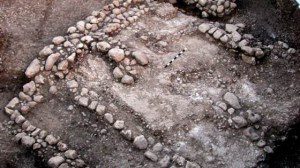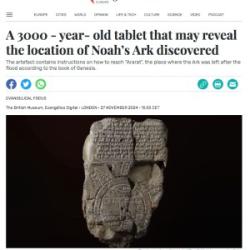Israel is putting its tax shekels to work, expanding Route 38, the main highway to Beit Shemesh. Highway projects can be tricky in Israel, though, involving not just the Ministry of Transportation, but also, quite often, the always busy Israel Antiquities Authority. Start digging to expand a highway in Israel and you never know what you’ll uncover: “10,000-year-old house among amazing finds unearthed in Israel.”
Archaeologists say they’ve uncovered some stunning finds while digging at a construction site in Israel, including stone axes, a “cultic” temple and traces of a 10,000-year-old house.
… The building seems to have undergone a number of renovations and represents a time when humans were first starting to live in permanent settlements rather than constantly migrating in search of food, the researchers said. Near this house, the team found a cluster of abandoned flint and limestone axes.
… The excavators also say they found the remains of a possible “cultic” temple that’s more than 6,000 years old. The researchers think this structure, built in the second half of the fifth millennium B.C., was used for ritual purposes, because it contains a heavy, 4-foot-tall (1.3 meters) standing stone that is smoothed on all six of its sides and was erected facing east.
That’s a pretty cool find, but as Megan Gannon reports, it’s not unusual news in Israel, where:
… construction projects often lead to new archaeological discoveries. For example, during recent expansions of Highway 1, the main road connecting Jerusalem and Tel Aviv, excavators discovered 9,500-year-old animal figurines, a carving of a phallus from the Stone Age and a ritual building from the First Temple era.
The wide range of artifacts there reflects the reality of life in Israel — a place where people have lived continuously for millennia. That continuous history is part of what gives such authority to the findings of the Antiquities Authority. When they say the house discovered under Route 38 is 10,000 years old, that figure is based on a host of data, including the fact that this house is clearly far older than the 6,000-year-old cultic ruins discovered nearby. The 10,000-year-old house is one more piece of the puzzle and the long, continuous timeline of history in Israel allows great confidence about where that puzzle-piece fits.

This new excavation at Eshtaol is about 15 miles west of Jerusalem. For another example of why such long timelines are so conclusive, just look about the same distance in the other direction, east of Jerusalem in Jericho. That’s the same Jericho as the one in the Bible — the place where Rahab sheltered Joshua’s spies. People have been living there, continuously, for about 11,000 years.
We know this. We have artifacts that show this indisputably. Arti-facts — facts that can be touched, held, photographed. We have evidence of successive settlements — building and rebuilding of the city — with layer upon undeniably older layer.
Fundamentalists and white evangelical Christians in America tend to like archaeology. Biblical Archaeology Review, which claims to have the largest paid circulation of any magazine about archaeology, is a popular magazine among white evangelical clergy. Evangelicals tend to like the idea of “biblical archaeology,” seeing the discovery of new artifacts in the lands of the Bible as evidence confirming the truth of their scriptures.
But American evangelicals do not like biblical archaeology when it finds things like a 10,000-year-old house in Eshtaol, or when it says that Jericho has been continuously occupied for 11,000 years. That’s because many American evangelicals have got it fixed in their heads that the Bible must only be read in such a way that it teaches that nothing is 10,000 years old. They insist that the book of Genesis and the genealogies of the Hebrew scriptures have to be read in a way that says the universe was created by God in six days about 7,000 years ago. For these evangelicals, then, anything said to be older than 7,000 years becomes “controversial.”
That’s a problem in places like Eshtaol and Jericho. Such sites have offered up many artifacts that are less than 7,000 years old. Those artifacts are not deemed “controversial.” A building is discovered in Jericho and archaeologists say it is 6,500 years old. Can we all agree that it is, in fact, 6,500 years old? Yes. We can and we do agree to this. Everyone agrees that building is 6,500 years old, even the American evangelicals. But what about the building found beneath that one? And beneath that one? Those must surely be older — far older — than the non-controversial 6,500-year-old building, yet here the evangelicals balk because now we’re crossing that uncrossable line into the realm of things that are older than they say the Bible says that anything could possibly be.
Something’s gotta give. You can’t have a 10,000-year-old house in a 7,000-year-old universe. And the Israel Antiquities Authority has just authoritatively stated that we’ve got ourselves a 10,000-year-old house.
Here, then, are the options for young-Earth creationist evangelicals reading the story above:
1. The Israel Antiquities Authority must be wrong. Archaeologists who say this house is 10,000 years old must be mistaken.
The problem with this response is that the archaeologists evaluating and dating the finds at Eshtaol aren’t doing anything unusual or deviating in any way from the standards of their science. If this dating of the finds at Eshtaol is doubtful, then all of archaeology is doubtful and it’s time to cancel our subscriptions to BAR.
This is also trickier because we’re dealing with archaeology, which offers a variety of different means for dating such discoveries. Thus the magical invocation of evangelical skepticism about carbon dating won’t work here. “Skepticism” is a generous term for this reflexive dismissal of the science for which Walter Libby earned a Nobel Prize in Chemistry. It amounts to nothing more than a series of stock phrases that can be recited like a protective spell. “Scientists say radiocarbon dating is flawed.” (Really? Which scientists? Name two. And why haven’t they stepped forward to claim their own Nobel for disproving the chemistry and math, correcting this universal error?) Or “Radiocarbon dating is often mistaken.” This assertion is repeated as protective bullshit — in the technical, Frankfurtian sense. It is not stated as something the speaker knows to be true, nor as something the speaker knows to be false. It is stated by someone who is unconcerned with whether it is true or false in the hopes of muddying the waters and changing the subject.
2. The Israel Antiquities Authority must be lying. Science is a gigantic, evil conspiracy and archaeologists must be in on it.
This approach is easier than the one above because it doesn’t require one to know anything at all about science or archaeology. To say that scientists are mistaken is to accept a responsibility to further suggest how they might be mistaken — to point to some mistake they may have made. Those too lazy to take on such homework can instead find refuge in claims of a scientific conspiracy. We don’t need to say how or why scientific claims are mistaken if we simply assert, instead, that everybody knows scientists are devious, immoral monsters serving some other agenda than finding the truth.
One appeal of such conspiracy theorizing is that it allows one to spin one’s ignorance as a form of sophistication. People who accept scientific conclusions based on evidence, experiment and observation can be condescendingly dismissed as naive. “You shouldn’t believe everything you hear on TV” can easily be expanded to become, “You shouldn’t believe anything you read in peer-reviewed science journals, museums, or universities.”
The downside of this conspiracy theory, of course, is that it would need to be breathtakingly vast — encompassing almost everyone other than the elect cognoscenti who alone stand against the grand conspiracy of lies. Such necessary vastness inverts the usual conspiratorial worldview. It turns the small handful of undeceived doubters into the secret cabal of guardians of occult truth. Instead of suggesting, as other conspiracies do, that the secret hand of the Knights Templar is behind all of human history, it says that we are the Knights Templar preserving our secret truth in opposition to all of history.
Plus it’s just goofy. If you want to dismiss the Israel Antiquities Authority as part of some ancient-universe conspiracy because they’re reporting the discovery of a 10,000-year-old house, then you might as well also accuse them of shooting JFK, faking the moon landing, and hiding the alien bodies from Roswell.
3. The Bible must be false.
If there is one and only one acceptable way of reading the Bible, and if that one and only one acceptable way of reading the Bible insists that nothing can be older than 7,000 years, then this 10,000-year-old house refutes the Bible. Therefore there is no God, Jesus is dead, and the Golden Rule is for suckers.
Most young-Earth creationists have convinced themselves that these are the stakes here. They’ve hypnotized themselves and their followers into accepting this “one and only one acceptable way of reading the Bible” mantra as though it were self-evidently true. And if that were true, then they conclude there can be only two binary options: Fundamentalist biblical inerrancy or nihilistic atheism. As David Rennie recently wrote for The Economist, this either/or insistence creates a fragile faith: “The seeming paradox of a strong faith in crisis is explained by rigidity: that which cannot bend may break instead.” Rigid but brittle. Young-Earth creationism creates a kind of faith that is vulnerable to being falsified by something as simple as a highway expansion project in Israel.
The proponents of young-Earth creationism all insist that this option must be considered as a possible response to any new scientific discovery. “If … then,” they’re always saying. If the universe could be proved to be any older than 7,000 years, then the Bible must be false. Yet they never seem to seriously consider taking this option themselves — preferring instead the BS or conspiracy theories above whenever they’re cornered into confronting it.
Unfortunately, though, the followers of those young-Earth proponents have been listening to this if … then, either/or mantra, and they have made the mistake of taking their spiritual leaders seriously. Those followers learn of something like this 10,000-year-old house, realize that it is not a mistake and not a lie told by a nefarious conspiracy of archaeologists, and then, following what they have been taught all their lives, they come to the only conclusion they’ve been told is left: Nihilistic atheism. This is why young-Earth creationism is such an efficient assembly-line for the mass production of ex-Christians.
The good news is that after the initial crisis and trauma of losing their rigid-and-brittle faith in young-Earth creationism, most of those ex-fundies eventually realize that nihilistic atheism isn’t their only option. Either they come to realize that atheism need not be nihilistic and amoral, or else they come to realize that there was another option besides the three we’ve discussed so far. Such as:
4. Young-earth creationism misreads the Bible. Maybe there is more than one and only one way to read the Bible.
This is the option that young-Earth creationists don’t like to talk about. Yes, they’ll act sad when some young followers of theirs lose their faith, but such occasions also, in effect, serve to reinforce the ideology of fundamentalism. Every time the rigid faith of some believer is shattered, it confirms that such rigidity is the essence of faith. Such defections thus are no threat to fundamentalism itself, but rather can be seen as validating the binary if … then, either/or construct at its core.
Far more dangerous to fundamentalist religion is the possibility of faith that can accommodate science and the reality of the universe around us.
The truth, in fact, is that most Christians have such faith. Most Christians do not read the first chapter of Genesis as a scientific text that must be read as a contradiction of every other scientific text. Most Christians do not see the excavations at Eshtaol as any kind of threat to our way of reading the Bible, or to our belief in God, or to our devotion to Jesus. We haven’t twisted ourselves into knots trying to read the Bible as something other than what it presents itself to be, and so we’re free to read an article like Molly Gannon’s above and just think, “Hey, cool, a 10,000-year-old house. Neat.”
And the further truth is that these other Christians are not adopting some new, “liberal” way of reading the Bible. They’re simply sticking to reading the Bible the way it was read before the parochial modern invention of young-Earth creationism. Their ways of reading the Bible pre-date the fundamentalist hermeneutic, which is itself a deviant, dead-end branch sticking off from the long history of Christians reading the Bible. (There’s a reason it’s called the “1978 Chicago Statement on Biblical Inerrancy” and not the Inerrancy Creed of the Council of Chicago in CE 78.)
Christians also aren’t the only ones reading the book of Genesis. Nor were we the first to do so. Here is Haviv Rettig Gur’s report on the Eshtaol find for The Times of Israel. Note that the tone of Gur’s piece, like Gannon’s, is a celebration of this wondrous discovery as wonderful news. “The house is the oldest structure ever found in the Judean lowlands, [Antiquities Authority researchers] said, dating back to the period known to archaeologists as the Pre-Pottery Neolithic.”
For young-Earth creationists, there cannot be any such thing as “the Pre-Pottery Neolithic.” Genesis 4 says that Tubalcain was an “artificer in brass and iron” before Noah’s flood, so young-Earth creationists don’t believe there ever was a Stone Age. Yet you won’t find any suggestion anywhere in Gur’s article that these researchers are challenging the legitimacy of the book of Genesis. That wouldn’t make sense because no one reads Genesis in such a weird way as to make that the case.
Well, almost no one. But Gur isn’t writing for an American audience, so he doesn’t have to account for the sensibilities of American evangelicals and the weird way they’ve come to misinterpret the Bible. That interpretation doesn’t matter to The Times of Israel because its readers live surrounded by daily, constant reminders of the times of Israel — the long times that “trace 10 millennia of human development,” as the subhed to Gur’s article says.
You can’t be a young-Earth creationist in Israel. Such a rigid, brittle scheme couldn’t survive in a land where every highway expansion project could easily turn unearth yet another crisis of faith.












